Soil Organic Carbon Dynamics in Response to Tillage Practices in the Steppe Zone of Southern Russia
Abstract
:1. Introduction
2. Materials and Methods
2.1. Study Area
2.2. Climate
2.3. Soil Sampling and Organic Carbon Analysis
2.4. Statistical Analysis
3. Results
3.1. Content of SOC in Virgin Soils
3.2. Changes in SOC Content in Conventional Tillage versus Virgin Soils
3.3. Comparison of the SOC Content and Reserves in NT versus CT
3.4. Impact of NT Technology on CO2 Sequestration
4. Discussion
5. Conclusions
Author Contributions
Funding
Institutional Review Board Statement
Informed Consent Statement
Data Availability Statement
Acknowledgments
Conflicts of Interest
References
- Bhardwaj, A.K.; Jasrotia, P.; Hamilton, S.K.; Robertson, G.P. Ecological management of intensively cropped agro-ecosystems improves soil quality with sustained productivity. Agric. Ecosyst. Environ. 2011, 140, 419–429. [Google Scholar] [CrossRef]
- Bonfante, A.; Terribile, F.; Bouma, J. Refining physical aspects of soil quality and soil health when exploring the effects of soil degradation and climate change on biomass production: An Italian case study. Soil 2019, 5, 1–14. [Google Scholar] [CrossRef] [Green Version]
- Poch, R.M.; dos Anjos, L.H.C.; Attia, R.; Balks, M.; Benavides-Mendoza, A.; Bolaños-Benavides, M.M.; Calzolari, C.; Chabala, L.M.; de Ruiter, P.C.; Francke-Campaña, S.; et al. Soil: The great connector of our lives now and beyond COVID-19. Soil 2020, 6, 541–547. [Google Scholar] [CrossRef]
- Thiele-Bruhn, S.; Schloter, M.; Wilke, B.-M.; Beaudette, L.A.; Martin-Laurent, F.; Cheviron, N.; Mougin, C.; Römbke, J. Identification of new microbial functional standards for soil quality assessment. Soil 2020, 6, 17–34. [Google Scholar] [CrossRef] [Green Version]
- Azarenko, M.A.; Kazeev, K.S.; Ermolaeva, O.Y.; Kolesnikov, S.I. Changes in the vegetation cover and biological properties of chernozems in the postagrogenic period. Eurasian Soil Sci. 2020, 11, 1412–1422. [Google Scholar]
- Man, M.; Wagner-Riddle, C.; Dunfield, K.E.; Deen, B.; Simpson, M.J. Long-term crop rotation and different tillage practices alter soil organic matter composition and degradation. Soil Tillage Res. 2021, 209, 104960. [Google Scholar] [CrossRef]
- Kudeyarov, V.N. Soil Respiration and Biogenic Carbon Dioxide Sink in the Territory of Russia: An Analytical Review. Eurasian Soil Sci. 2018, 51, 599–612. [Google Scholar] [CrossRef]
- Kuzyakov, Y. Sources of CO2 Efflux from Soil and Review of Partitioning Methods. Soil Biol. Biochem. 2006, 38, 425–448. [Google Scholar] [CrossRef]
- Oertel, C.; Matschullat, J.; Zurba, K.; Zimmermann, F.; Erasmi, S. Greenhouse Gas Emissions from Soils—A Review. Geochemistry 2016, 76, 327–352. [Google Scholar] [CrossRef] [Green Version]
- Weller, S.; Florentine, S.; Javaid, M.M.; Welgama, A.; Chadha, A.; Chauhan, B.S.; Turville, C. Amaranthus retroflexus L. (Redroot Pigweed): Effects of Elevated CO2 and Soil Moisture on Growth and Biomass and the Effect of Radiant Heat on Seed Germination. Agronomy 2021, 11, 728. [Google Scholar] [CrossRef]
- Meinshausen, M.; Meinshausen, N.; Hare, W.; Raper, S.C.; Frieler, K.; Knutti, R.; Frame, D.J.; Allen, M.R. Greenhouse-gas emission targets for limiting global warming to 2 °C. Nature 2009, 458, 1158–1162. [Google Scholar] [CrossRef] [PubMed]
- Batjes, N.H. Total carbon and nitrogen in the soils of the world. Eur. J. Soil Sci. 1996, 47, 151–163. [Google Scholar] [CrossRef]
- National Report. In The Global Climate and Soil Cover in Russia: Assessment of Risks and Environmental and Economic Consequences of Land Degradation. Adaptive Systems and Technologies for Rational Environmental Management (Agriculture and Forestry); Bedritsky, A.I. (Ed.) Soil Institute im. V.V. Dokuchaeva, GEOS: Moscow, Russia, 2018; p. 357. [Google Scholar]
- Stolbovoy, V.; Ivanov, A. Carbon balance in soils of Northern Eurasia. In Soil Carbon, Progress in Soil Science; Springer: Cham, Switzerland, 2014; pp. 381–390. [Google Scholar] [CrossRef]
- Gristina, L.; Keesstra, S.; Novara, A. No-till durum wheat yield success probability in semi arid climate: A methodological framework. Soil Tillage Res. 2018, 181, 29–36. [Google Scholar] [CrossRef]
- Kogut, B.M.; Semenov, V.M. Estimation of soil saturation with organic carbon. Dokuchaev Soil Bull. 2020, 102, 103–124. [Google Scholar] [CrossRef]
- Kurganova, I.N.; Lopez de Guerinu, V.O.; Shvidenko, A.Z.; Sapozhnikov, P.M. Changes in the total pool of organic carbon in fallow soils in Russia in 1990–2004. Soil Sci. 2010, 3, 361–368. [Google Scholar]
- Kurganova, I.N.; Lopez de Guerinu, V.O.; Mostovaya, A.S.; Ovsepyan, L.A.; Telesnina, V.M.; Lichko, V.I.; Baeva, Y.I. Influence of the processes of natural reforestation on the microbiological activity of postagrogenic soils of the European part of Russia. Lesovedenie 2018, 1, 3–23. [Google Scholar]
- Mokrikov, G.V.; Minnikova, T.V.; Myasnikova, M.A.; Kazeev, K.S.; Kolesnikov, S.I. Change in content and composition of organic substance of Priazovie chernozem when using direct seeding technology. Agrochemistry 2020, 1, 18–24. (In Russian) [Google Scholar]
- Sanderman, J.; Hengl, T.; Fiske, G.J. Soil carbon debt of 12,000 years of human land use. Proc. Natl. Acad. Sci. USA 2017, 114, 9575–9580. [Google Scholar] [CrossRef] [Green Version]
- Wuaden, C.R.; Nicoloso, R.S.; Barros, E.C.; Grave, R.A. Early adoption of no-till mitigates soil organic carbon and nitrogen losses due to land use change. Soil Tillage Res. 2020, 204, 104728. [Google Scholar] [CrossRef]
- Ghimire, R.; Thapa, V.R.; Cano, A.; Acosta-Martinez, V. Soil organic matter and microbial community responses to semiarid croplands and grasslands management. Appl. Soil Ecol. 2019, 141, 30–37. [Google Scholar] [CrossRef]
- Gura, I.; Mnkeni, P.N.S. Crop rotation and residue management effects under no till on the soil quality of a Haplic Cambisol in Alice, Eastern Cape, South Africa. Geoderma 2019, 337, 927–934. [Google Scholar] [CrossRef]
- Larionova, A.A.; Ermolaev, A.M.; Nikitishen, V.I.; de Gerenyu, V.O.L.; Evdokimov, I.V. Carbon budget in arable gray forest soils under different land use conditions. Eurasian Soil Sci. 2009, 42, 1364–1373. [Google Scholar] [CrossRef]
- Sokolov, M.S.; Glinushkin, A.P.; Spiridonov, Y.Y.; Toropova, E.Y.; Filipchuk, O.D. Technological features of soil-protective resource-saving agriculture (in the development of the FAO concept). Agrochemistry 2019, 5, 3–22. [Google Scholar]
- Corbeels, M.; Marchão, R.L.; Neto, M.S.; Ferreira, E.G.; Madari, B.E.; Scopel, E.; Brito, O.R. Evidence of limited carbon sequestration in soils under no-tillage systems in the Cerrado of Brazil. Sci. Rep. 2016, 6, 21450. [Google Scholar] [CrossRef] [PubMed] [Green Version]
- Laudicina, V.A.; Novara, A.; Barbera, V.; Egli, M.; Badalucco, L. Long-Term Tillage and Cropping System Effects on Chemical and Biochemical Characteristics of Soil Organic Matter in a Mediterranean Semiarid Environment. Land Degrad. Dev. 2015, 26, 45–53. [Google Scholar] [CrossRef]
- Zhang, S.; Chang, L.; McLaughlin, N.B.; Cui, S.; Wu, H.; Wu, D.; Liang, W.; Liang, A. Complex soil food web enhances the association between N mineralization and soybean yield—A model study from long-term application of a conservation tillage system in a black soil of Northeast China. Soil 2021, 7, 71–82. [Google Scholar] [CrossRef]
- Doraiswamy, P.C.; McCarty, G.W.; Hunt, E.R.; Yost, R.S.; Doumbia, M.; Franzluebbers, A.J. Modeling soil carbon sequestration in agricultural lands of Mali. Agric. Syst. 2007, 94, 63–74. [Google Scholar] [CrossRef]
- Franzluebbers, A.J.; Causarano, H.J.; Norfleet, M.L. Soil conditioning index and soil organic carbon in the Midwest and southeastern United States. J. Soil Water Conserv. 2011, 66, 178–182. [Google Scholar] [CrossRef] [Green Version]
- Franzluebbers, A.J.; Hubbs, M.D.; Norfleet, M.L. Evaluating soil organic carbon sequestration potential in the Cotton Belt with the soil conditioning index. J. Soil Water Conserv. 2012, 67, 378–389. [Google Scholar] [CrossRef] [Green Version]
- Olson, K.R. Impacts of tillage, slope, and erosion on soil organic carbon retention. Soil Sci. 2010, 175, 562–567. [Google Scholar] [CrossRef]
- González-Sánchez, E.J.; Moreno-García, M.; Kassam, A.; Holgado-Cabrera, A.; Triviño-Tarradas, P.; Carbonell-Bojollo, R.; Pisante, M.; Veroz-González, O.; Basch, G. Conservation Agriculture: Making Climate Change Mitigation and Adaptation Real in Europe; European Conservation Agriculture Federation: Cordoba, Spain, 2017. [Google Scholar] [CrossRef]
- Kazeev, K.S.; Minnikova, T.V.; Mokrikov, G.V.; Kolesnikov, S.I. Effect of Conservation Tillage on Soil Quality of Southern Russia. Indian J. Ecol. 2020, 47, 668–675. [Google Scholar]
- Minnikova, T.V.; Mokrikov, G.V.; Kazeev, K.S.; Akimenko, Y.V.; Kolesnikov, S.I. Estimation of relationship between hydrothermal indicators and enzymative activity of chernozem Rostov region when using different agrotechnologies. Agrophysics 2018, 1, 9–17. (In Russian) [Google Scholar]
- Mokrikov, G.V.; Kazeev, K.S.; Myasnikova, M.A.; Akimenko, Y.V.; Kolesnikov, S.I. Influence of direct sowing technology on soil mesofauna, respiration and enzymatic activity of southern chernozems. Agrochem. Bull. 2019, 5, 31–36. (In Russian) [Google Scholar]
- Scavo, A.; Abbate, C.; Mauromicale, G. Plant allelochemicals: Agronomic, nutritional and ecological relevance in the soil system. Plant Soil 2019, 442, 23–48. [Google Scholar] [CrossRef]
- Kong, C.-H.; Xuan, T.D.; Khanh, T.D.; Tran, H.-D.; Trung, N.T. Allelochemicals and Signaling Chemicals in Plants. Molecules 2019, 24, 2737. [Google Scholar] [CrossRef] [Green Version]
- Mirzaei, M.; Anari, M.G.; Razavy-Toosi, E.; Asadi, H.; Moghiseh, E.; Saronjic, N.; Rodrigo-Comino, J. Preliminary Effects of Crop Residue Management on Soil Quality and Crop Production under Different Soil Management Regimes in Corn-Wheat Rotation Systems. Agronomy 2021, 11, 302. [Google Scholar] [CrossRef]
- Oburger, E.; Jones, D. Sampling root exudates—Mission impossible? Rhizosphere 2018, 6, 116–133. [Google Scholar] [CrossRef]
- Kazeev, K.S.; Kolesnikov, S.I.; Akimenko, Y.V.; Dadenko, E.V. Biodiagnostic Methods of Terrestrial Ecosystems; Publishing House of the Southern Federal University: Rostov-on-Don, Russia, 2016; p. 356. [Google Scholar]
- Aliev, S.A. Accumulation Conditions and Nature of Soil Organic Matter, 1st ed.; Publishing house of Academy of Sciences of Azerbaijan: Baku, Azerbaijan, 1966; 281p. [Google Scholar]
- Chernova, O.V.; Bezuglova, O.S. Principles and features of the compilation of the red data book of soils of the steppe regions (on example of the Rostov oblast). Arid Ecosyst. 2018, 8, 28–37. [Google Scholar] [CrossRef]
- Dadenko, E.V.; Myasnikova, M.A.; Kazeev, K.S.; Kolesnikov, S.I.; Valkov, V.F. Biological activity of ordinary chernozem during long-term use for arable land. Eurasian Soil Sci. 2014, 6, 724–730. [Google Scholar]
- Milkheev, E.Y.; Chimitdorzhieva, G.D.; Tsybenov, Y.B. Amphiphilic components of humic substances in meadow-chernozemic permafrost soils and burozem. Agrochemistry 2018, 6, 25–29. [Google Scholar]
- Rusanov, A.M.; Shein, E.V. The modern stage in the evolution of soils and vegetation of agricultural lands of the Orenburg region. Bull. Mosc. University. Ser. 17 Soil Sci. 2013, 4, 38–42. [Google Scholar]
- Dymov, A.A.; Nizovtsev, N.A. Amphiphilic properties of soil organic matter in parcels of prevailing coniferous trees of the middle taiga. Theor. Appl. Ecol. 2015, 1, 62–68. [Google Scholar]
- Kögel-Knabner, I.; Amelung, W. Dynamics, chemistry and preservation of organic matter in soils. In Treatise on Geochemistry; Holland, H.D., Turekian, K.K., Eds.; Elsevier: Oxford, UK, 2014; pp. 157–215. [Google Scholar]
- Blanco-Canqui, H. No-till technology has limited potential to store carbon: How can we enhance such potential? Agric. Ecosyst. Environ. 2021, 313, 107352. [Google Scholar] [CrossRef]
- Report on the State and Use of Agricultural Land in the Russian Federation in 2018: M; FGBNU “Rosinformagrotech”: Moscow, Russia, 2020; p. 340.
- Minasny, B.; Malone, B.P.; McBratney, A.B.; Field, D.J.; Odeh, I.; Padarian, J.; Stockmann, U.; Angers, D.A.; McConkey, B.G.; Arrouays, D.; et al. Soil carbon 4 per mille. Geoderma 2017, 292, 59–86. [Google Scholar] [CrossRef]
- Nilsson, S.; Shvidenko, A.; Stolbovoi, V.; Gluck, M.; Jonas, M.; Obersteiner, M. Full Carbon Account for Russia; Interim Report IR-00-021; International Institute for Applied Systems Analysis (IIASA): Laxenburg, Austria, 2000; p. 181. Available online: http://pure.iiasa.ac.at/id/eprint/6185/1/IR-00-061.pdf (accessed on 1 December 2021).
- Ivanov, A.L.; Stolbovoy, V.S. The 4 ppm initiative is a new global challenge for soils in Russia. Bull. V.V. Dokuchaev 2019, 98, 185–202. [Google Scholar] [CrossRef]
- Derpsch, R.; Friedrich, T.; Kassam, A.; Hongwen, L. Current status of adoption of no-till farming in the world and some of its main benefits. Int. J. Agric. Biol. Eng. 2010, 3, 1–26. [Google Scholar]
- Minnikova, T.V.; Mokrikov, G.V.; Kazeev, K.S.; Kolesnikov, S.I. The influence of agricultural crops on the enzymatic activity of chernozems of the Rostov region using various agricultural technologies. Agrochemistry 2020, 10, 20–27. [Google Scholar]
- Soane, B.D.; Ball, B.C.; Arvidsson, J.; Basch, G.; Moreno, F.; Roger-Estrade, J. No-till in northern, western and south-western Europe: A review of problems and opportunities for crop production and the environment. Soil Tillage Res. 2012, 118, 66–87. [Google Scholar] [CrossRef] [Green Version]
- Hu, X.; Li, Z.; Chen, J.; Nie, X.; Liu, J.; Wang, L.; Ning, K. Carbon sequestration benefits of the grain for Green Program in the hilly red soil region of southern China. Int. Soil Water Conserv. Res. 2021, 9, 271–278. [Google Scholar] [CrossRef]
- Mokrikov, G.V.; Minnikova, T.V.; Kazeev, K.S.; Kolesnikov, S.I. Influence of precipitation and moisture reserves on the yield of crops under different tillage. Agron. Res. 2019, 17, 2350–2358. [Google Scholar]
- Mokrikov, G.V.; Minnikova, T.V.; Kazeev, K.S.; Kolesnikov, S.I. Use of soil enzyme activity in assessing the effect of no-till in the south of Russia. Agron. Res. 2021, 19, 171–184. [Google Scholar]
- Jian, J.; Bond-Lamberty, B.; Hao, D.; Sulman, B.; Patel, K.; Zheng, J.; Dorheim, K.; Pennington, S.; Hartman, M.; Warner, D.; et al. Leveraging observed soil heterotrophic respiration fluxes as a novel constraint on global-scale models. Glob. Chang. Biol. 2021, 27, 5392–5403. [Google Scholar] [CrossRef] [PubMed]
- Cordeau, S.; Baudron, A.; Adeux, G. Is Tillage a Suitable Option for Weed Management in Conservation Agriculture? Agronomy 2020, 10, 1746. [Google Scholar] [CrossRef]
- Popov, P.D. Calculation of the balance of straw in the farm: Method. In Recommendations; Popov, P.D., Novikov, M.N., Eds.; VNIPTIOU: Vladimir, Russia, 1987; p. 110. (In Russian) [Google Scholar]
- Kogut, B.M.; Sysuev, S.A.; Kholodov, V.A. Water resistance and labile humic substances of typical chernozem under different land use. Pochvovedenie 2012, 5, 555–561. (In Russian) [Google Scholar]
- Elliott, E.T. Aggregate structure and carbon, nitrogen, and phosphorus in native and cultivated soils. Soil Sci. Soc. Am. J. 1986, 50, 627–633. [Google Scholar] [CrossRef]
- Schepaschenko, D.; Mukhortova, L.; Shvidenko, A.; Vedrova, E.F. The Pool of Organic Carbon in the Soils of Russia. Eurasian Soil Sci. 2013, 46, 107–116. [Google Scholar] [CrossRef] [Green Version]
- Stell, E.; Warner, D.; Jinshi, J.; Lamberty, B.; Vargas, R. Spatial biases of information influence global estimates of soil respiration: How can we improve global predictions? Glob. Chang. Biol. 2021, 27, 3923–3938. [Google Scholar] [CrossRef]
- Mukhortova, L.; Schepaschenko, D.; Moltchanova, E.; Shvidenko, A.; Khabarov, N.; See, L. Respiration of Russian soils: Climatic drivers and response to climate change. Sci. Total Environ. 2021, 785, 147314. [Google Scholar] [CrossRef]
- Artemyeva, Z.S.; Kogut, B.M. The Effect of Tillage on Organic Carbon Stabilization in Microaggregates in Different Climatic Zones of European Russia. Agriculture 2016, 6, 63. [Google Scholar] [CrossRef] [Green Version]
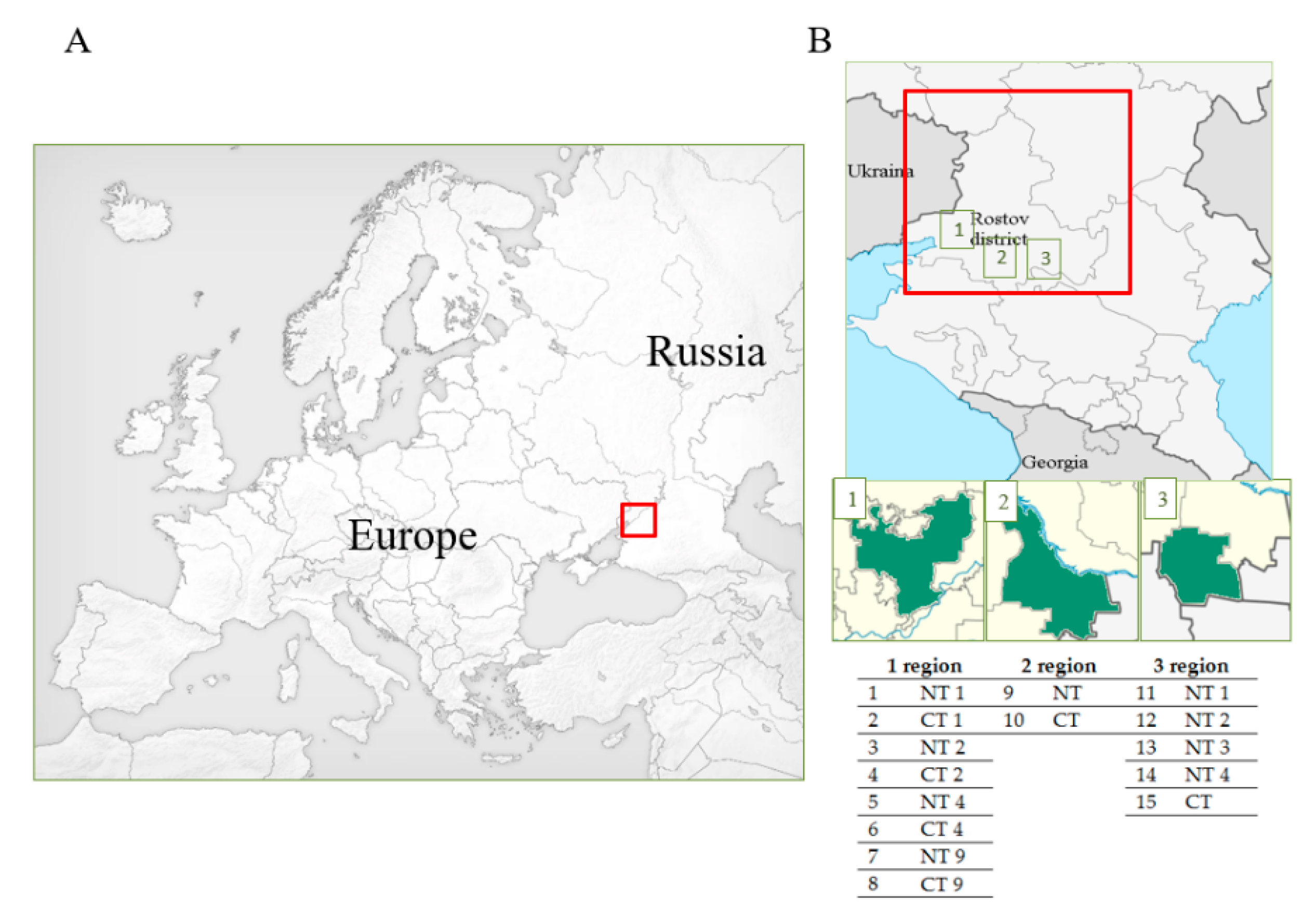
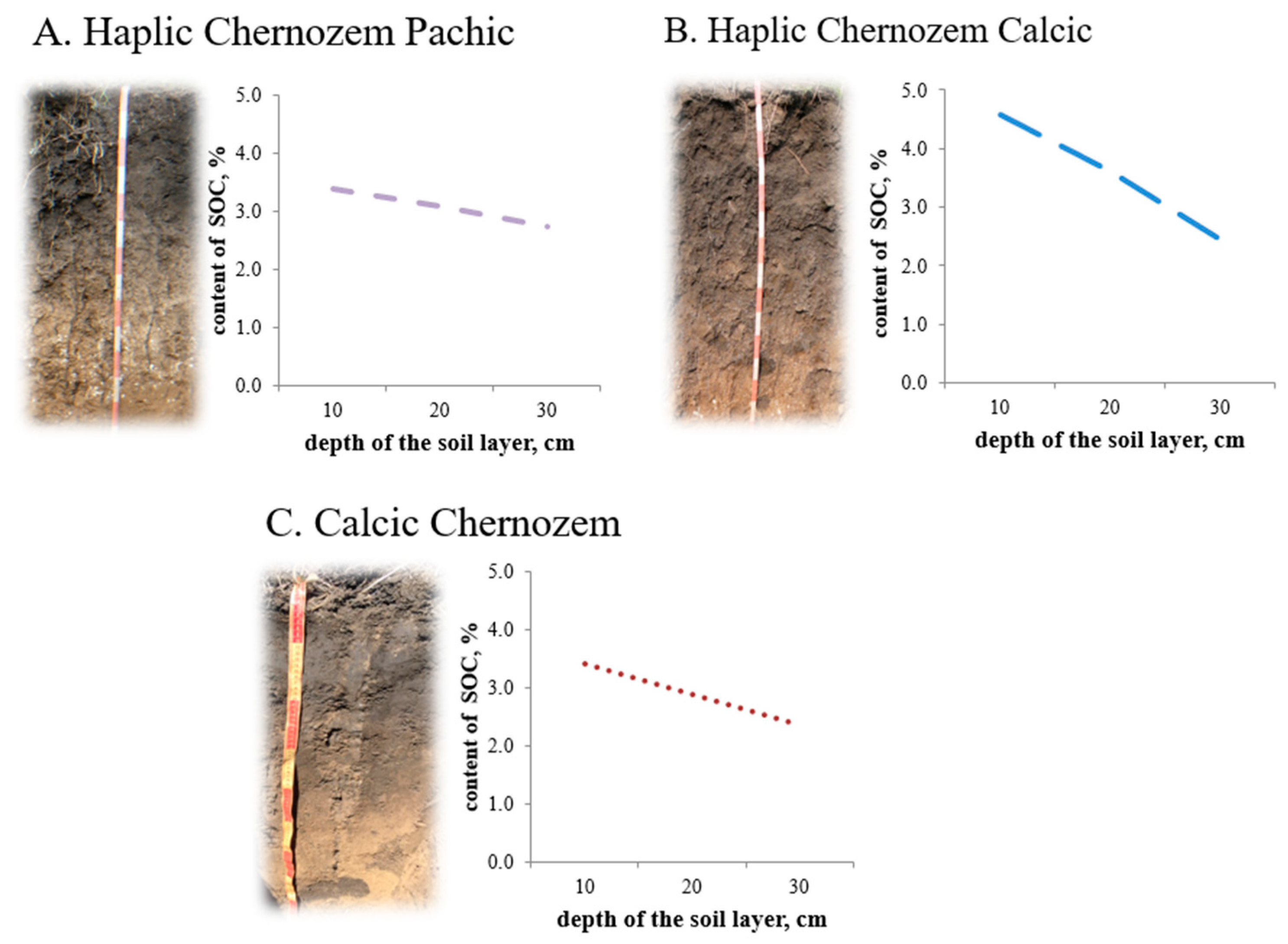
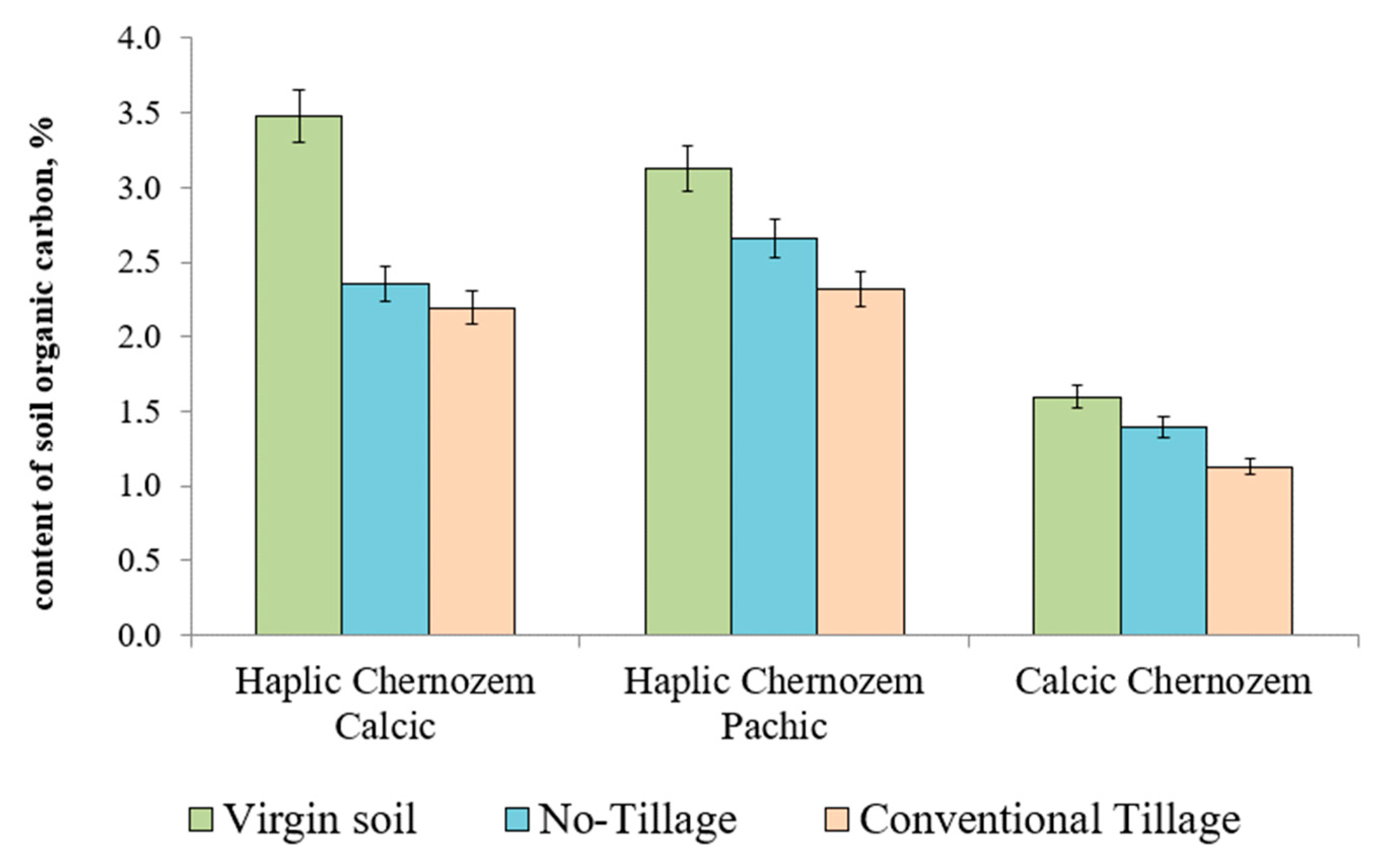
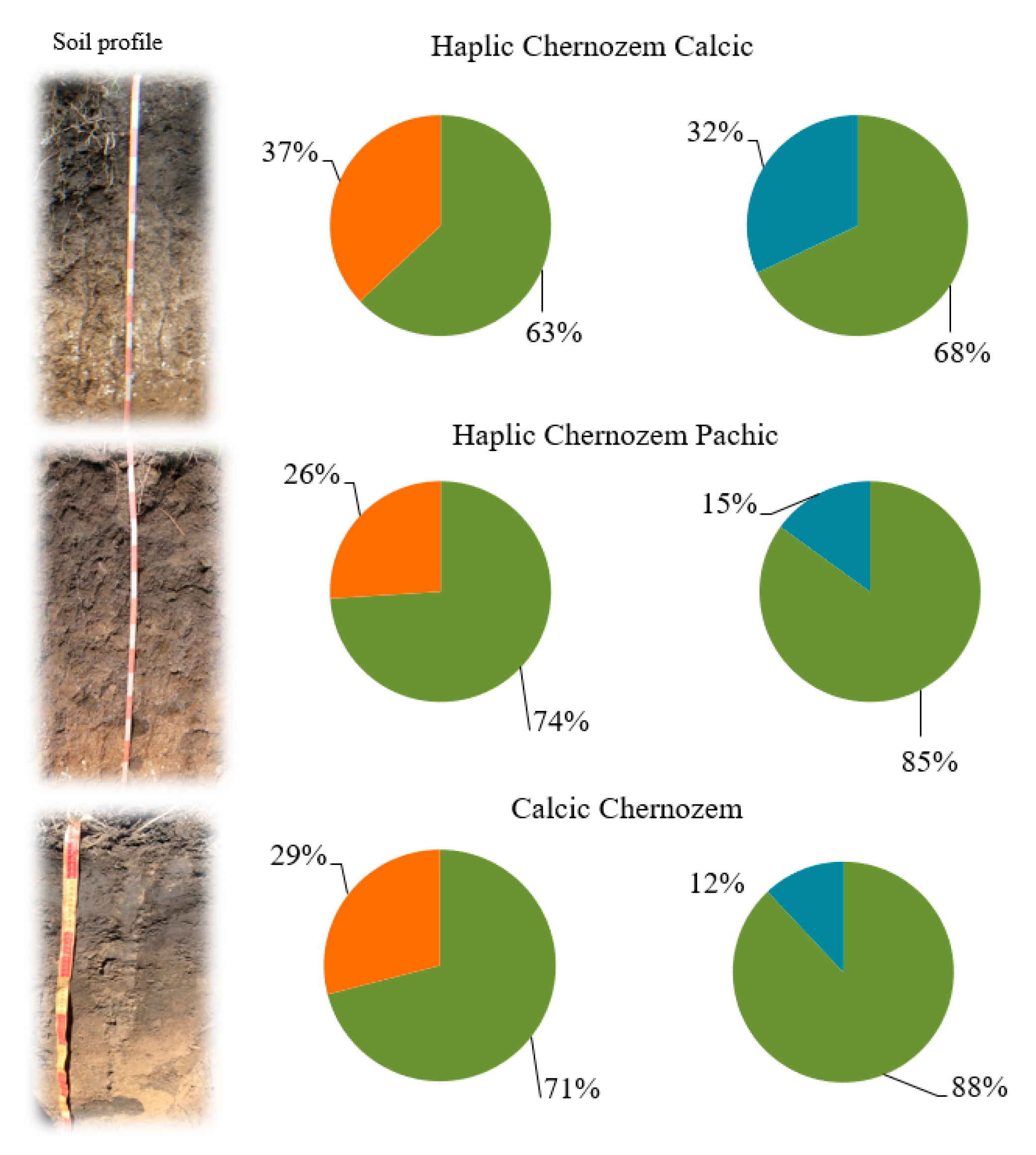
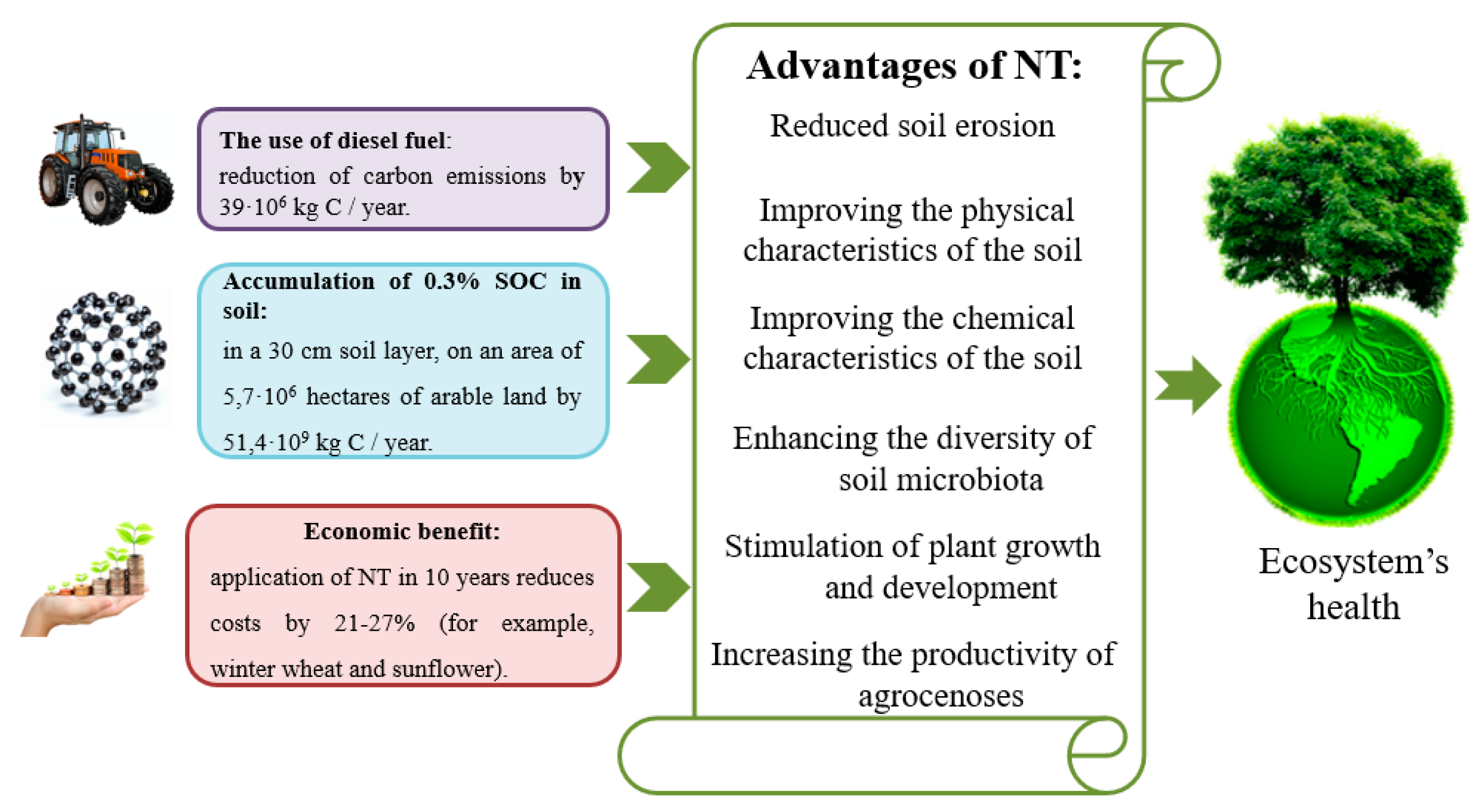
| Point No. | Agricultural Crop | |||
|---|---|---|---|---|
| 1 Year | 2 Year | 3 Year | ||
| Haplic Chernozem Calcic (Region no. 1) | ||||
| 1 | NT 1 | Línum | Wheat | Pea |
| 2 | CT 1 | Wheat | Wheat | Barley |
| 3 | NT 2 | Línum | Wheat | Sunflower |
| 4 | CT 2 | Wheat | Wheat | Barley |
| 5 | NT 4 | Coriándr | Wheat | Sunflower |
| 6 | CT 4 | Barley | Wheat | Barley |
| 7 | NT 9 | Sunflower | Wheat | Mustard |
| 8 | CT 9 | Sunflower | Wheat | Pea |
| Haplic Chernozem Pachic (Region no. 2) | ||||
| 9 | NT | Wheat | Wheat | Wheat |
| 10 | CT | Wheat | Wheat | Wheat |
| Calcic Chernozem (Region no. 3) | ||||
| 11 | NT 1 | Sunflower | Sunflower | Sunflower |
| 12 | NT 2 | Corn | Corn | Corn |
| 13 | NT 3 | Pea | Pea | Pea |
| 14 | NT 4 | Wheat | Wheat | Wheat |
| 15 | CT | Wheat | Wheat | Wheat |
| No | Type of Soil | TSUM | TWIN | WW | NF |
|---|---|---|---|---|---|
| 1 | Haplic Chernozem Calcic | +22–+23 | −6–−9 | 260–300 | 165–175 |
| 2 | Haplic Chernozem Pachic | +22–+23 | -4–−5 | 270–300 | 180–190 |
| 3 | Calcic Chernozem | +23–+24 | -5–−7 | 250–280 | 170–180 |
| No | Type of Soil | SOCaver % | SOCres. 103 kg·ha−1 | SOCen MJ·ha−1 |
|---|---|---|---|---|
| 1 | Haplic Chernozem Calcic | 1.9 ± 0.5 2.4 ± 0.6 | 83.6 ± 1.4 131.2 ± 2.4 | 43,2 ± 3.7 67.8 ± 1.4 |
| 2 | Haplic Chernozem Pachic | 3.4 ± 0.7 4.6 ± 1.1 | 75.6 ± 4.1 120.5 ± 5.2 | 39.1 ± 1.8 62.3 ± 3.9 |
| 3 | Calcic Chernozem | 1.8 ± 0.2 2.4 ± 0.1 | 23.7 ± 2.8 31.4 ± 3.9 | 12.2 ± 1.2 16.2 ± 1.1 |
Publisher’s Note: MDPI stays neutral with regard to jurisdictional claims in published maps and institutional affiliations. |
© 2022 by the authors. Licensee MDPI, Basel, Switzerland. This article is an open access article distributed under the terms and conditions of the Creative Commons Attribution (CC BY) license (https://creativecommons.org/licenses/by/4.0/).
Share and Cite
Minnikova, T.; Mokrikov, G.; Kazeev, K.; Medvedeva, A.; Biryukova, O.; Keswani, C.; Minkina, T.; Sushkova, S.; Elgendy, H.; Kolesnikov, S. Soil Organic Carbon Dynamics in Response to Tillage Practices in the Steppe Zone of Southern Russia. Processes 2022, 10, 244. https://doi.org/10.3390/pr10020244
Minnikova T, Mokrikov G, Kazeev K, Medvedeva A, Biryukova O, Keswani C, Minkina T, Sushkova S, Elgendy H, Kolesnikov S. Soil Organic Carbon Dynamics in Response to Tillage Practices in the Steppe Zone of Southern Russia. Processes. 2022; 10(2):244. https://doi.org/10.3390/pr10020244
Chicago/Turabian StyleMinnikova, Tatiana, Gregory Mokrikov, Kamil Kazeev, Anna Medvedeva, Olga Biryukova, Chetan Keswani, Tatiana Minkina, Svetlana Sushkova, Hadeer Elgendy, and Sergey Kolesnikov. 2022. "Soil Organic Carbon Dynamics in Response to Tillage Practices in the Steppe Zone of Southern Russia" Processes 10, no. 2: 244. https://doi.org/10.3390/pr10020244









